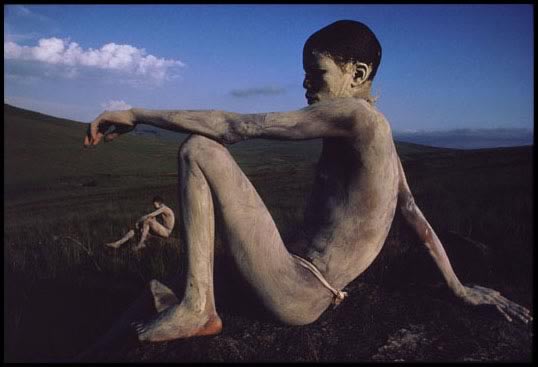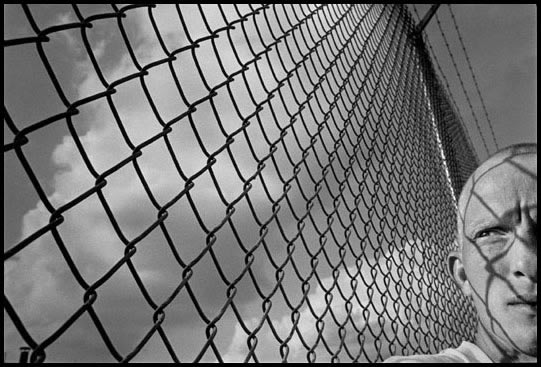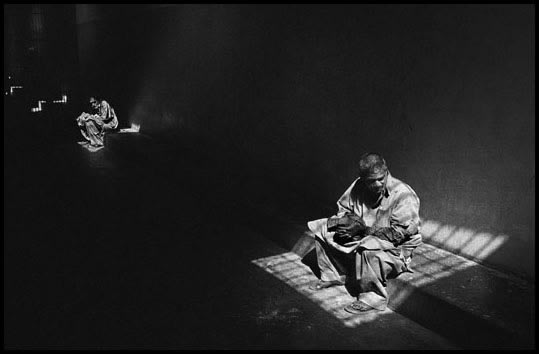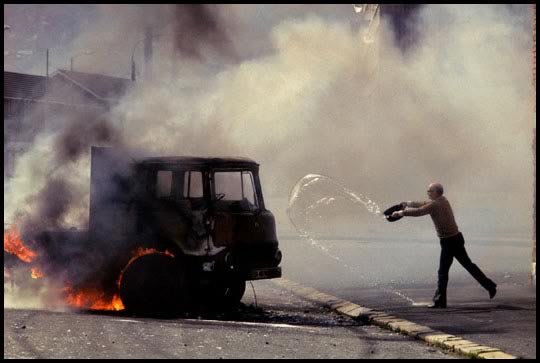The following blog post contains an overview of the photojournalist James Nachtwey's life and career. Each hyperlink brings you to a MP3 clip of me talking about varying aspects of Nachtwey's career including his source of motivation, types of technology utilized, ethical challenges that he faced, and the impact that he has had on society. Images of Nachtwey's work are included within the blog to accompany the spoken words.
 |
| Image Source: http://vsmeets.wordpress.com/2011/07/13/as-close-as-it-gets-james-nachtwey/ Image By: Unknown |
The destruction and devastation which occurred following the terrorist attacks of 9/11 is difficult to look at. Having lived though it, known people affected by it, and visited the memorial recently, seeing images like this one from James Nachtwey are tough to swallow. Nachtwey took many photos of the aftermath of that event which were published in magazines and newspapers across the country. This image captures the rubble, the firefighters, and the smoke cloud from the explosions in a way different than most pictures from that day. The quality of light in the photo makes the scene look strangely calm. As the sun sets in the background and the people in the picture are standing still, its hard to grasp the continued panic that we all know was taking place still at this time. Furthermore, the perspective of the photo, looking out through a "peephole" makes it seem like Nachtwey is detached from the misery before him, allowing him to spy down on what is happening yet not have to get too close. Finally, this picture is unique in the sense that as a viewer, I'm not positive what the main subject is. Is it the smoke clouding the building in the background? The piles of rubble? or The workers standing in the lower center of the picture. Here Nachtwey captured an event that most people today know all too well, in a completely unique way.
 |
| Image Source: http://www.time.com/time/photogallery/0,29307,1660644_1442573,00.html Image By: James Nachtwey |
This image captured by Nachtwey in 1992 shows a young teenage boy who is exhibiting part of a right of passage in his country of South Africa. Adolescents here go though a part of the ceremony where they are covered in white powder and stay like that for a few days. The picture shows a large close-up main subject who is taking up a great proportion of the screen. The powder on his skin creates a texture that makes him appear soft and gentile, though he has a bony structure with defined muscles. The image also shows another male in the background, likely doing the same thing. Both boys look bored and disinterested. The image makes me want to learn more about them. I want to know more about the tradition and it intrigues me why the boy is ignoring the camera entirely.
 |
| image Source: http://www.jamesnachtwey.com/ Image By: James Nachtwey |
This image by Nachtwey of a prisoner on the chain gang from Alabama in 1994 got my attention right away. The perspective of the photo is intriguing as it appears that the camera is very close to the subject, yet the subject seems to be unfazed. Before reading the caption I would have guessed that the subject was quite a bit younger. The angle of his face and apparent disappearance of his body do not give any clues away to how old the boy is. The use of lines from the fence give an interesting vantage point to the photo, and the reflection of the lines on the individuals face makes the entire picture feel threatening. The black and white color scheme too gives the whole "prison feeling" to everyone. Just as there is only black and white coloring in the picture, there are only two options with photography, take the photo, or do not.
 |
| Image Source: http://www.jamesnachtwey.com/ Image By: James Nachtwey |
The following image is from Pakistan in 2001. The image captures men inside a rehab center where they are treated while recovering from Heroin addictions. Nachtwey makes use of the photographers tool "rule of thirds" as he positions his camera to not only cover the main subject in the right two thirds of the frame, but also to capture others that are sitting further down the tunnel in the background. The photo is simple yet impact-full. Dark lighting and shadows contribute to a feeling of tragedy, and painstakingly slow progress. The image is not cluttered by too much activity. The emptiness and segregation between the men in the pictures is a further reminder of how alone they must feel as they go through the painful withdrawal process from Heroin.
 |
| Image Source: http://www.jamesnachtwey.com/ Image By: James Nachtwey |
This image of a man attempting to put out a large fire on a truck in Northern Ireland in 1981 demonstrates the extent to which protests and political stands were taken in order to prove a point. The image is a perfect example of the idea of "the decisive moment". Nachtwey as the photographer makes sure to capture the exact moment that the man is releasing the water from his pail. Though there is a lot of movement going on in the image, that deceive moment was captured by Nachtwey. Using a fast shutter speed the water and the man are captured using relatively precise clarity. The other textures in the picture, combined with the challenges to keep everything in focus while capturing such a decisive moment mean that other background portions of the image are slightly blurred. The smoke gives the image texture as it puffs out around the truck. The combination of these elements give the photo the feeling of "a snapshot in time".
 |
| Image Source: http://www.jamesnachtwey.com/ Image By: James Nachtwey |
The final photo is an image taken by Nachtwey in Haiti, displaying a statue famous in the country, standing above a pile of burning ruins. The contrast between the foreground and background makes the photo extremely impactful. The light from the fire casts a dark shadow on the statue and gives it a silhouette feeling. It allows the statue to be a larger more prominent presence. Furthermore, the darkness of the edges of the photo draw the attention further to the pile of rubble. The light from the fire peaks through pieces of splintered wood and trash and gives dimension to something that may otherwise just have been a pile of junk. The picture personifies the statue and everything symbolic about it as it stands tall over the destruction. The colors of the fire are warm, yet the topic itself is cold. The significance of the statue still standing is a testament to Haiti's perseverance and desire as they overcame significant challenges in their country.
 |
| Image Source: http://www.time.com/time/photogallery/0,29307,1957522_2030384,00.html Image By: James Nachtwey |
References
http://www.jamesnachtwey.com/
http://www.war-photographer.com/en/
http://www.britannica.com/EBchecked/topic/401388/James-Nachtwey
http://www.ted.com/talks/james_nachtwey_s_searing_pictures_of_war.html
http://rap361.com/?p=14901
http://www.burnmagazine.org/in-the-spotlight/2012/02/wim-wenders/
http://thedartmouth.com/2012/04/26/news/nachtwey
http://equipboard.com/pros/james_nachtwey
http://www.l-camera-forum.com/leica-forum/leica-m8-forum/32329-james-nachtwey.html
http://www.heinzawards.net/recipients/james-nachtwey
http://www.war-photographer.com/en/
http://www.britannica.com/EBchecked/topic/401388/James-Nachtwey
http://www.ted.com/talks/james_nachtwey_s_searing_pictures_of_war.html
http://rap361.com/?p=14901
http://www.burnmagazine.org/in-the-spotlight/2012/02/wim-wenders/
http://thedartmouth.com/2012/04/26/news/nachtwey
http://equipboard.com/pros/james_nachtwey
http://www.l-camera-forum.com/leica-forum/leica-m8-forum/32329-james-nachtwey.html
http://www.heinzawards.net/recipients/james-nachtwey
No comments:
Post a Comment